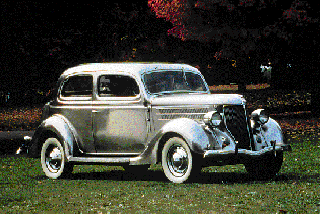
The years between 1885 and 1945 constitute an era of profound and sweeping
change around the world. During those years, the industrial revolution brought about
major upheavals in all aspects of society. Modern modes of transportation and communication
transformed people’s sense of time and space. So, too, did innovations like Einstein’s
theory of relativity and Freud’s perception of consciousness. New political ideologies,
such as Fascism and Communism, reshaped national identities. Both reflecting and refracting
the spirit of the age, the artists, architects and designers of the time actively
promoted, shaped and challenged modernity.

The exhibition Designing the Modern World 1885–1945: The Arts of Reform and Persuasion features examples of design at the height of the industrial age in the context of social, technological and aesthetic issues. The exhibition’s sculptures, paintings, prints, furniture, ceramics and appliances explore the intended messages of the objects and the ways that design contributed to the perception of the modern world.
To provide a historical framework within which these objects were created, and to show how the artists of the time were responding to modernity, the exhibition is divided into three sections.
From 1885 until World War I, conflicts raged between those who resisted modernity and those who embraced it, and these tensions characterized all design movements of the time. The most influential movement was Arts and Crafts, which originated in Britain as a reaction to an increasingly mechanized society. Its proponents believed that the industrial process had stripped the craftsman of his individuality, and they vowed to change society by changing the nature of their work. The “joy of labor” would be restored by handmade objects, and anonymous, shoddy work would be abolished. The hope was that simplification and attention to local customs, geography and materials would reduce costs and make products more accessible to a wider public, not only the wealthy.
Arts and Crafts ideals, or a reaction to them, contributed to three other movements prior to World War I: Romantic Nationalism, in which design was used to express a country’s identity, usually through folk crafts or regional architecture; Art Noveau, which turned to nature, particularly to plant forms, for inspiration; and Industrial Design, which attempted to use machines to provide affordable good design while upholding the highest standards of manufacture. All four movements presented ways of living in the modern world by offering a certain amount of escape from it, or conversely, by making compromises that recognized modernity’s inevitability and eagerly accepting its potential.
While the conflict between machine-made and handmade, between standardization and individuality, went unresolved, in the 1920s and ‘30s people began to embrace modernity.
Again, advertising and works of art were means of communicating an era’s reaction to the modern.
Societies both democratic and totalitarian were faced with a need to domesticate, or familiarize, the influences of the machine age. Governments and corporations called upon artists to create designs that would help persuade ambivalent citizens that new modes of living increased prosperity without eroding traditional values or threatening economic stability.
Artists employed a variety of stylistic solutions to the “struggle to make ourselves at home in a constantly changing world.” They rejoiced in new modes of transportation and communication—in the qualities of speed, dynamism, even violence. They showed how embracing technology could affect visions of the future, including the idealization of the vertical city (embodied in Manhattan) and utopian planning at world’s fairs. They explored new materials such as tubular steel, and machine imagery such as streamlining, where aerodynamic forms were applied to objects from cars to cocktail shakers. Artists also offered a more “moderate” modernism to those who sought continuity with the past. An updated classicism dominated, with the application of columns, urns and Roman drapery to both furnishings and buildings.
Historically, governments have always pressed artists into service, but the late 19th and mid 20th centuries are especially notable for the use of design in promoting political agendas and social ideals. New world orders were reflected in architecture, painting, decorative arts and design as rulers of recently formed authoritarian regimes in Italy, Germany and the Soviet Union used propaganda to build support. Leaders of existing democratic systems also tried to rally their citizens, particularly during the Depression and the two world wars.
The ultimate goal was to translate abstract ideologies into concrete forms and create the illusion of a unified national culture, a “culture of consent” that transcended ethnic, regional and social distinctions.
Designers and artists adopted different strategies of persuasion to promote political ends in Nazi Germany and Fascist Italy, in New Deal America, in the new Soviet Union and in an increasingly unstable Europe. Some groups turned to the traditional and familiar while others insisted that only innovative forms of art and design could convey the revolutionary essence of new political systems. Designers used classical imagery from all over the political spectrum to convey stability. In Italy, columns, the eagle and the fascio (the emblem of the Fascist party) stood as icons evoking continuity with the glories of the ancient Roman empire. Avant-garde styles, however, were also embraced in Italy. Futurism, which glorified speed, motion and the violent rejection of the past, was often employed to assert the dynamism of the new Fascist state and to champion its contributions to technological advances.
Compiled by Perrin Rowland
Weisshouse at the Carnegie, near the exhibition’s exit, gives visitors an opportunity to shop for household items with a contemporary design flavor. This shop is a branch of the Weisshouse, a modern design store in Shadyside and Squirrel Hill. The Weisshouse provides a sense of how the objects and design issues presented in the exhibition are relevant to everyday life.
Tours of Designing the Modern World are given Tues.–Sat. at 1:30 p.m. and Sun. at 3:00 p.m. Also available for $2.00 are individual acoustiguides that allow visitors to view the works of art in any order while touring the exhibition.
Pick up a free brochure listing lectures, films and other related programs, or call 622-3288.